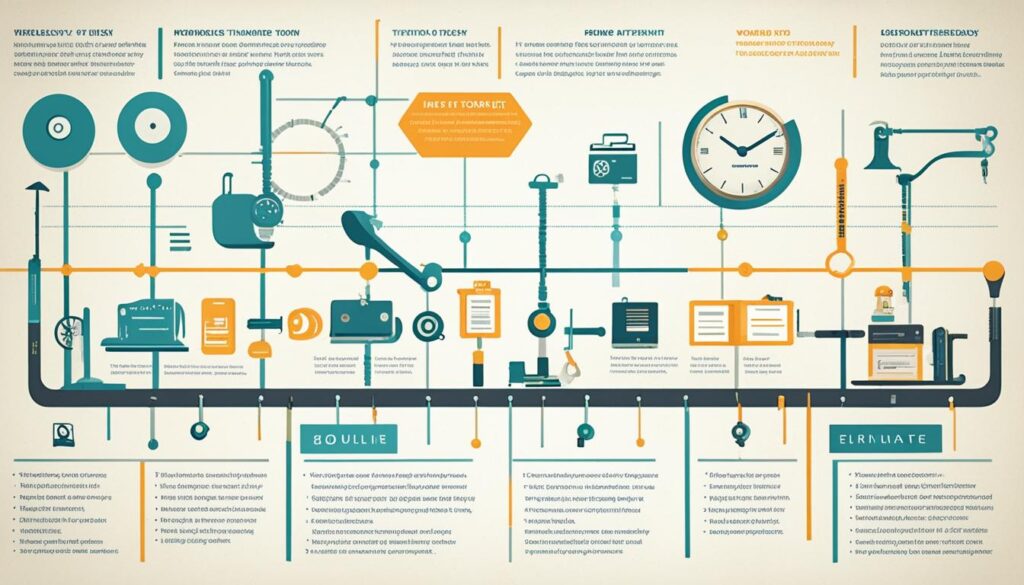Welcome to our article exploring the productivity of a 40-hour work week and its impact on work-life balance. In today’s fast-paced world, full-time jobs often entail long work hours that can leave little time for personal pursuits and relaxation. But is this traditional work schedule truly the most efficient and effective way to get things done?
Research suggests that focusing solely on the number of hours worked may not lead to optimal productivity. In fact, longer work hours can often result in diminishing returns and negative consequences for overall well-being. It’s important to consider alternative workweek models that promote a healthier work-life balance while still achieving the desired results.
In this article, we’ll explore the evolution of the 40-hour work week, debunk the myth that longer hours lead to increased productivity, discuss alternative workweek models, and make the case for a shorter workweek that prioritizes employee satisfaction and mental wellness. Are you ready to delve into the world of work schedules and discover what might be the best fit for you? Let’s get started!
The Evolution of the 40-Hour Work Week
The 40-hour work week has a rich history that dates back to the 19th century. It originated as a response to labor movements that fought for fair working conditions and reasonable hours. However, the official codification of the 40-hour work week came later with the enactment of the Fair Labor Standards Act in 1937.
During that time, traditional manufacturing-based industries were the backbone of the global economy. The 40-hour work week provided a standardized structure for full-time employment, ensuring that workers had adequate rest and leisure time.
Fast forward to the present day, and we find ourselves in a vastly different work culture. The shift from manufacturing to information and service-based work, coupled with rapid technological advancements, has redefined the way we view work and personal time.
In today’s interconnected world, boundaries between work and personal life have become blurred. With the advent of smartphones and remote work capabilities, it’s common for employees to be “always on,” constantly connected to their job responsibilities. This increased availability and the pressure to remain productive can significantly impact work-life balance.
“The global economy has evolved, and so should our approach to work hours.”
The evolving work culture raises questions about the continued relevance of the 40-hour work week. Is it still the most effective way to maximize productivity and maintain a healthy work-life balance in today’s fast-paced world?

| Benefits of the 40-Hour Work Week | Challenges of the 40-Hour Work Week |
|---|---|
| * Provides a standard work schedule | * Blurred lines between work and personal time |
| * Allows for work-life balance | * Increased pressure to remain constantly connected |
| * Promotes productivity within set hours | * Impact on mental health due to long hours |
These changes in the way we work call for a reassessment of our traditional workweek models. Additional research and an open-minded approach may reveal alternative solutions that better align with our modern work culture, promoting both productivity and employee well-being.
The Productivity Myth: Longer Hours vs. Shorter Workdays
Contrary to popular belief, longer work hours do not necessarily result in increased productivity. In fact, research indicates that employees can be more productive when they work less than eight hours a day. Overworking can lead to stress, burnout, and various health issues, which ultimately decrease productivity and contribute to higher absenteeism.
Studies have shown that excessive work hours can negatively affect mental and physical well-being. Prolonged periods of stress and burnout can lead to decreased focus, creativity, and problem-solving abilities. Additionally, chronic work-related stress can increase the risk of developing health conditions such as cardiovascular disease, hypertension, and depression.
“Working long hours does not necessarily mean you’re getting more work done. In fact, it can have the opposite effect, leading to decreased productivity and overall well-being,” says Dr. Sarah Johnson, a leading expert in work-life balance.
On the other hand, shorter workdays have been found to have several benefits for both employees and employers. By implementing flexible work arrangements and shorter work hours, companies can create a work environment that promotes work-life balance and prioritizes employees’ well-being.
Shorter workdays have been associated with increased productivity and job satisfaction. When employees have more time for rest and relaxation, they are more likely to feel refreshed, motivated, and engaged when they return to work. This renewed energy translates into higher quality work, improved efficiency, and better overall performance.
Moreover, shorter workdays allow employees to prioritize their personal lives and engage in activities that support their well-being, such as spending time with family, pursuing hobbies, and engaging in physical exercise. This balance between work and personal life is essential for long-term job satisfaction and overall life satisfaction.
Comparison of Longer Hours vs. Shorter Workdays
| Aspects | Longer Hours | Shorter Workdays |
|---|---|---|
| Productivity | May decrease over time due to fatigue, stress, and burnout | May increase due to improved focus, motivation, and well-being |
| Employee Health | Increased risk of stress-related conditions and health issues | Better physical and mental health outcomes |
| Job Satisfaction | May decline due to work-life imbalance and high levels of stress | Higher levels of job satisfaction and overall life satisfaction |
Implementing shorter workdays or flexible work arrangements requires a shift in work culture and management practices. Companies need to prioritize outcomes and results rather than the number of hours worked. Additionally, effective communication, proper workload management, and supportive work environments are key to ensuring the success of shorter workdays.
In conclusion, the idea that longer work hours necessarily lead to increased productivity is a myth. In reality, overworking can have detrimental effects on employee well-being and overall performance. Embracing shorter workdays can not only improve productivity but also contribute to better work-life balance and employee satisfaction.

Embracing Alternative Work Week Models
In today’s rapidly changing work landscape, many countries and companies are recognizing the need for alternative workweek models to promote flexibility, productivity, and employee satisfaction. One such model gaining popularity is the four-day workweek, which allows employees to work longer hours for four days and enjoy a three-day weekend. Additionally, flexible schedules are being implemented to accommodate individual needs and responsibilities.
Studies have shown that alternative workweek models can have a positive impact on various aspects of work-life balance. For instance, a four-day workweek has been associated with increased productivity, as employees feel more motivated and focused during their shorter work days. This concentrated effort can often lead to completing tasks more efficiently and effectively.
Furthermore, alternative workweek models provide employees with the opportunity to pursue personal interests and spend quality time with their families and loved ones. This improved work-life balance contributes to higher levels of job satisfaction and overall well-being.
Implementing alternative workweek models requires more than just reducing work hours. It entails reevaluating work processes, adopting flexible scheduling systems, and fostering a supportive work culture that values work-life balance. By adapting to these new models, companies can foster a work environment where employees thrive and achieve their best work.

Benefits of Alternative Workweek Models
| Benefits | Explanation |
|---|---|
| Increased Productivity | Employees are more focused and motivated, leading to higher levels of productivity. |
| Improved Work-Life Balance | Employees have more time for personal pursuits and family, resulting in better work-life balance. |
| Enhanced Employee Satisfaction | Alternative workweek models promote job satisfaction and overall well-being, leading to happier employees. |
Introducing alternative workweek models may require careful planning and consideration to ensure the smooth transition and effective implementation. Communication between employers and employees is vital to address potential challenges and tailor the new work schedules to meet everyone’s needs.
Embracing alternative workweek models not only benefits employees but also creates a more productive and happier workforce. By embracing flexibility and reimagining traditional work schedules, companies can foster a work environment that prioritizes both productivity and employee well-being.
As businesses continue to evolve and adapt to the changing demands of the modern workforce, alternative workweek models offer a practical and effective solution for achieving a better work-life balance, increased productivity, and overall employee satisfaction.
The Case for a 32-Hour Work Week
Some companies are recognizing the limitations of the traditional 40-hour work week and are championing the adoption of a shorter work schedule. While the standard 40 hours may have been suitable for past generations, research shows that employee productivity sharply declines after working for more than 50 hours a week. Additionally, longer work hours can have detrimental effects on employee health and well-being, leading to burnout and decreased job satisfaction.
Enter the 32-hour work week, a concept that advocates for a four-day workweek or reduced daily hours. This alternative workweek model has garnered attention for its potential to revolutionize the way we work by striking a better balance between work and personal life.
Implementing a 32-hour work week can have significant benefits for both employees and employers. By dedicating fewer hours to work, employees can experience increased engagement, improved work-life balance, enhanced mental wellness, and boosted overall satisfaction. Moreover, studies have shown that a shorter workweek can lead to higher productivity during the hours worked, as employees are more focused, energized, and motivated to perform.
“A 32-hour work week can increase employee engagement, improve work-life balance, enhance mental wellness, and boost overall satisfaction.”
This shift towards a 32-hour work week promotes a results-oriented approach rather than focusing solely on the number of hours worked. It encourages companies to prioritize efficiency, effectiveness, and outcomes, allowing employees to have more control over their time and flexibility to manage both work and personal responsibilities.
Companies that have adopted the 32-hour work week have seen positive results. Employees report feeling less stressed, more fulfilled, and better able to manage their personal lives. In turn, this increased job satisfaction and well-being can lead to higher employee retention rates and reduced absenteeism, ultimately benefiting the company’s bottom line.
Implementing a 32-hour work week may require adjustments in workflow, communication, and workload distribution. However, the potential benefits of increased employee engagement, improved productivity, and reduced burnout far outweigh the challenges of transitioning to a shorter workweek.
In conclusion, embracing a 32-hour work week has the potential to revolutionize the way we work, creating a healthier and more productive work environment. By prioritizing employee well-being and work-life balance, companies can cultivate a more engaged and satisfied workforce that drives success and innovation.
Conclusion
The traditional 40-hour work week, established in the early 20th century, may no longer be the most suitable structure for today’s evolving workforce and economy. The shift to information and service-based work and advancements in technology have created new challenges and opportunities in the modern workplace.
Research has shown that longer work hours can have negative effects on employee health and productivity. In contrast, alternative workweek models, such as shorter workdays or a four-day workweek, offer potential solutions to improve productivity, work-life balance, and employee satisfaction.
As we navigate the complexities of the modern work environment, it’s crucial to reevaluate and reshape our traditional workweek models. By adopting more flexible and efficient work schedules, we can better align with contemporary work realities and prioritize the well-being of employees. Embracing alternative workweek models can bring about positive changes and create a more productive and fulfilling work environment for all.
FAQ
Is the 40-hour work week still the best for productivity?
Research suggests that longer work hours don’t necessarily lead to increased productivity. Many companies are exploring alternative workweek models, such as shorter workdays or a four-day workweek, which have shown to improve productivity and employee satisfaction.
How did the 40-hour work week originate?
The 40-hour work week originated in the 19th century as a result of labor movements and was later codified in the Fair Labor Standards Act of 1937.
Do longer work hours increase productivity?
Research indicates that employees can be more productive when they work less than eight hours a day. Overworking can lead to stress, burnout, and various health issues, which ultimately decrease productivity.
Are there alternative work week models being embraced?
Yes, several countries and companies are exploring alternative workweek models, such as shorter workdays or a four-day workweek. These trials have often resulted in increased productivity, improved work-life balance, and higher employee satisfaction.
What are the benefits of a 32-hour work week?
A 32-hour work week, or a four-day workweek, has been shown to increase employee engagement, improve work-life balance, enhance mental wellness, and boost overall satisfaction.
Should we reconsider the traditional 40-hour work week?
With the changing nature of work and advancements in technology, it may be time to reconsider the traditional 40-hour work week and embrace more flexible and efficient work schedules.
